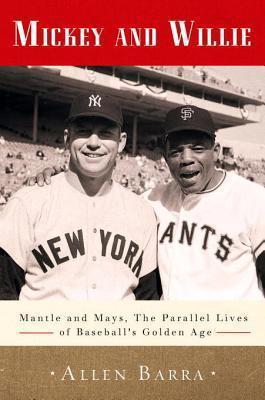For the last few weeks, I spent my commutes to and from work, as well as my time in the car running errands and driving back and forth to Kansas City, listening to an audiobook: Mickey and Willie: Mantle and Mays, the Parallel Lives of Baseball’s Golden Age by Allen Barra. For some reason, it never occurred to me to consider the two men simultaneously. I suppose that it didn’t fully click that they played Major League Baseball at the same time (funny how clueless I can be about something that I usually feel I know so well!). But I am glad to have come across this biographical study of how the lives and careers of Mickey Mantle and Willie Mays paralleled each other in so many ways.
In spite of the fact that their backgrounds differed so greatly, Mantle and Mays were virtually the same age, practically the same size (though Mantle was slightly bigger), and they both arrived in New York at the same time. Both played center field and both had close relationships with their dominant fathers as they grew up in the South.
They even paralleled one another in the ways that they differed. Mantle was white, Mays was black. Mickey drank heavily, while Willie couldn’t stand alcohol. Mickey stayed married to one woman, but was a notorious womanizer. Meanwhile, Willie Mays married twice, but if there were any extramarital affairs, he kept them private.
The biggest thing these men shared in common was their celebrity and the expectations that came with that fame. Both players experienced the fickleness of celebrity, being cheered one moment and booed in the next. Each had a song written about him (“Say Hey (The Willie Mays Song)” and “I Love Mickey”). When Mantle was rejected for military service, fans turned on him for being a draft dodger. When the Giants moved from New York to San Francisco, Willie Mays was booed for not being Joe DiMaggio and, likely, for being black.
The question of who was the better player comes up frequently in the book. The answer Barra seems to hint at appears to indicate that it was Willie Mays, though Mickey Mantle would’ve had the title if only he would have taken better care of himself. Mantle himself publicly conceded that Mays was the better player. Mays, evidently the more prideful of the two, hated the idea of anyone being considered better than himself.
Barra puts his own personal touch into the book as well. He discusses his own idolization of Mickey Mantle and Willie Mays. He even admits that, the older he became and the more he learned about the two ballplayers, the more disillusioned he became. Even in spite of this, he continued to admire them, accepting the fact that, in spite of their greatness on the diamond, Mantle and Mays were only men, after all.
All in all, I found this book a worthwhile read (or, in my case, a worthwhile listen). The reader gets biographies of two players simultaneously, and it is done in a fashion that presents a perspective not usually found in biographies.




